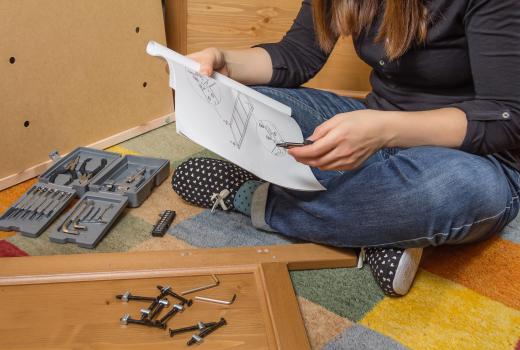A pilot hole is a small hole created in a surface to act as a guide for drilling, screwing, or nailing. There are a number of reasons to create a pilot hole, and several different techniques can be used. One of the most common involves the use of a drill with a small bit to make the hole, although people can also create a pilot hole by driving in a small nail partway, and then removing the nail, leaving a neat hole behind.
One of the most common reasons to drill a pilot hole is to avoid slippage. When drilling large-bore holes, it is not uncommon for the drill bit to skid or slip, which can damage the material and potentially endanger the drill operator. Small holes are easier to drill, so a pilot hole can be sunk first, and then the larger bit can be centered over the pilot hole to make the hole larger. This is much safer than starting out with a big bit, and it can improve accuracy, as the bit will not slide and end up creating a hole in the wrong place.

Drilling pilot holes is often recommended with hardwoods, because they can be tough to work with. Attempting to drive a screw or large-bore drill through a hardwood without using a hole which has already been started can be a frustrating process. The bit may slip, skidding on the wood and damaging it, and the hole may end up uneven or angled.
Another reason to create a pilot hole is to avoid cracking or splitting of the surface being worked with. Wood and plastic both tend to be prone to cracking when large holes are drilled or when a screw is sunk in. A pilot hole reduces the strain on the material, making cracking less likely. This can be especially critical with delicate materials or irreplaceable materials; although drilling the pilot hole takes time, it's preferable to causing permanent damage to something which cannot be repaired or replaced.
Pilot holes are also used as guides. Flatpack furniture often comes with pilot holes, both to show people how to assemble the furniture and to minimize the requirement for extra tools. Predrilled holes also eliminate the risk of cracking, a common concern with cheaper woods and plastics used to make some flatpack furniture products. For projects people are doing on their own, a pilot hole can improve accuracy, as the hole which has already been started is the one which a screw, drill bit, or nail will naturally slip into.
Ever since she began contributing to the site several years ago, Mary has embraced the exciting challenge of being a About Mechanics researcher and writer. Mary has a liberal arts degree from Goddard College and spends her free time reading, cooking, and exploring the great outdoors.

